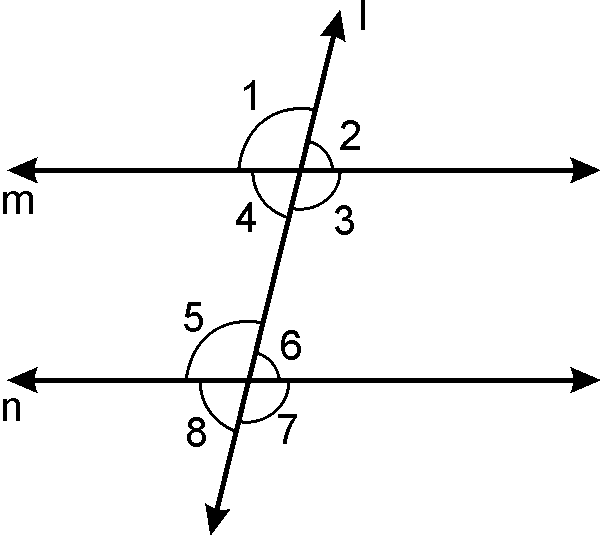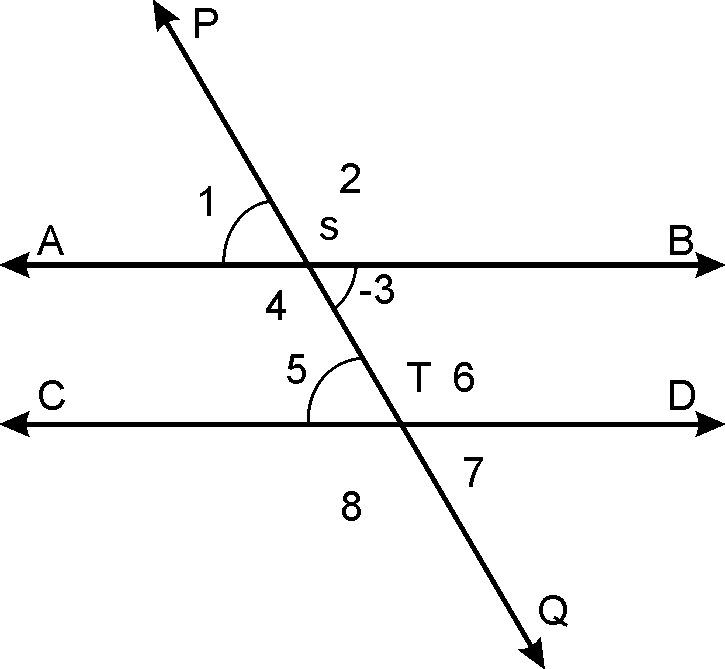Collinear points:
If
three or more points lie on same line they are called collinear points.

Angle: Angle is forms when two rays originate from
same endpoint.

Vertex: The end point of angle is called vertex.
Arms: The rays making an angle are called the arms.
Adjacent angles:
Two angles are called adjacent angles if
they have a common vertex, a common arm, and non-common arms are on different
sides of the common arms.

Linear pair angles:
If for adjacent angles, the non common pair rays
form a line, then angles so formed are
called angles
of linear pair.

Linear pair Axiom:
i)If a ray stands on a line, then sum of
two adjacent angles so formed is .
ii)If the sum of two adjacent angles ,then a ray stands on a line.
Vertically Opposite angles :
When two
lines AB and CD intersect each other, and are called vertically opposite
angles.

Theorem:
If two lines intersect each other, then the
verically opposite angles angles are equal.
Given: AB,
CD are two lines which intersect at point O.

To prove:
Proof:
(Linear
pair axiom)….1
(Linear pair axiom)….2
Adding st. 1 and st. 2
(From
1 and 2)
Proved.
Similarly, we can prove
Parallel lines and transversal:

1)
Corresponding angles: When a transversal intersects two parallel lines, Corresponding
angles are angles which lie on same side
of transversal and both lie above or below the two lines.
1) and
2) and
3) and
4)
and
2) Alternate angles:
1) and
2)
and
3) Interior angles:
1) and
2) and
Corresponding angle axiom:
1) If
a transversal intersects two parallel lines, then each pair of corresponding
angles equal.
2) If
a transversal intersects two lines such that a pair of corresponding angles is
equal, then two lines are parallel to each other.
Theorem: If a transversal
intersects two parallel lines then, each pair of alternate angle is equal.

Given:
, is
transversal.
To prove:
or
or
Proof :
or (By
corresponding axiom).(1)
But or (Vertically opposite angle)….(2)
or (From 1 and 2).
Proved.
Theorem 2:
If a transversal intersects two Parallel
Lines then each pair of interior angles on the same
side of transversal is supplementary.

Given:
, is transversal.
To prove :
or And
or
Proof:
(Alternate angle theorem)….1
But
(Linear pair)……..2
(From
1 and 2)
Or
Hence proved.
Similarly, we can prove
Theorem 3: Converse of the theorem:
If a transversal intersects two
lines such that a pair of angles on the same side of
transversal is supplementary then two lines
are parallel.

Given:
Lines AB and {CD, PQ} is transversal.
To prove :
AB is parallel to CD.
Proof:
(Given)…1
(Linear pair)….2
(By corresponding angle axiom).
Theorem 4:
Lines which are
parallel to same line are parallel to each other.

Given:
Line line
Line line
To prove:
Line line
Proof:
Line line
(Corresponding angle axiom)…..1
Line line
(Corresponding angle axiom)…2
(From 1 and 2)
Line line (Corresponding angle axiom).
Theorem 5:
If two parallel lines are intersected by a transversal bisectors of any
pair of alternate interior angles are parallel.

Given:
PQ is transversal.
MT is bisector of
NS is bisector of
To prove: MT NS
Proof: Let
(Alternate angles)
(By alternate angle theorem)
Theorem 6 :Angle sum property
The sum of the
angles of a triangle is

Given: in
To prove:

Construction: Draw line parallel to QR passing through P
Proof:
(Linear
angles)…(1)
If PQ is transversal,
(Alternate angles)…(2)
PR is transversal,
(Alternate angles)…(3)
From 1,
2 and
3
Theorem 7: Exterior angle theorem:
If a side of a
triangle is produced, then the exterior angle so formed is equal to the sum of
two interior opposite angles.

Given:
And
To prove:
Proof:
(By angle sum property of triangle)…1
(Linear pair)…2
(From 1 and 2)

![]()












